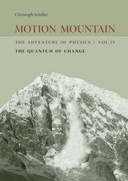
Motion Mountain - The Quantum of Change: Volume IV of The Adventure of Physics
Christoph Schiller
2019
This book series is for anybody who is curious about motion in nature. How do things, people, animals, images and empty space move? The answer leads to many adventures, and this volume presents those due to the discovery that there is a smallest possible change value in nature. This smallest change value, the quantum of action, leads to what is called quantum physics. In the structure of modern physics, quantum physics covers four of eight points. The present volume introduces the foundations of quantum theory, explains the structure of atoms and the appearance of probabilities, wave functions and colours.
The present introduction to quantum physics arose from a threefold aim I have pursued since 1990: to present the basics of quantum motion in a way that is simple, up to date and captivating.
This work is a sequel of Motion Mountain - Light, Charges and Brains: Volume III of The Adventure of Physics.
Motion Mountain - Motion Inside Matter - Pleasure, Technology and Stars: Volume V of the Adventure of Physics is a sequel of this work.
Why read this book? Have your say.
You must be logged in to comment.
Rights Information
Are you the author or publisher of this work? If so, you can claim it as yours by registering as an Unglue.it rights holder.Downloads
- 544 - pdf (CC BY-NC-ND) at Unglue.it.
Keywords
- atomic physics
- Biology
- Biophysics
- Bohr
- Chemistry
- decoherence
- Dirac equation
- electron
- elementary particles
- entanglement
- gauge theory
- Interference
- material science
- matter waves
- Nuclear physics
- origin of colours
- photon
- photon counting
- Planck's constant
- Planck's constant
- Probability
- quantum physics
- Quantum field theory
- quantum mechanics
- quantum of action
- quantum particles
- Quantum theory
- Schrödinger equation
- Schroedinger equation
- Science
- Science / Physics
- Science / Physics / Quantum Theory
- Solid state physics
- spin
- spin-statistics
- spinor
- strong interaction
- Textbooks
- tunnel effect
- wave function
- wave function collapse
- weak interaction
Links
web: http://www.motionmountain.net/quantum.htmlEditions

